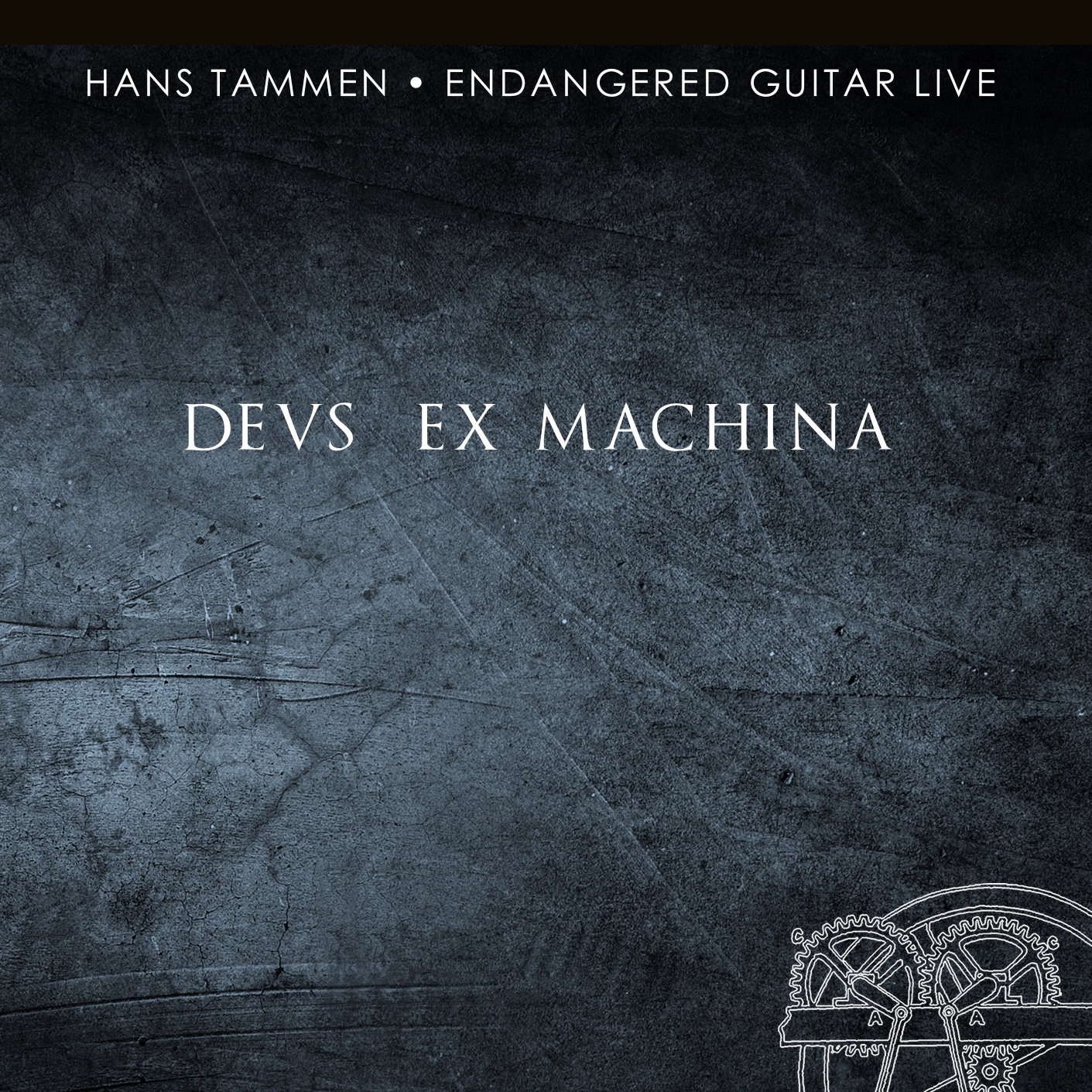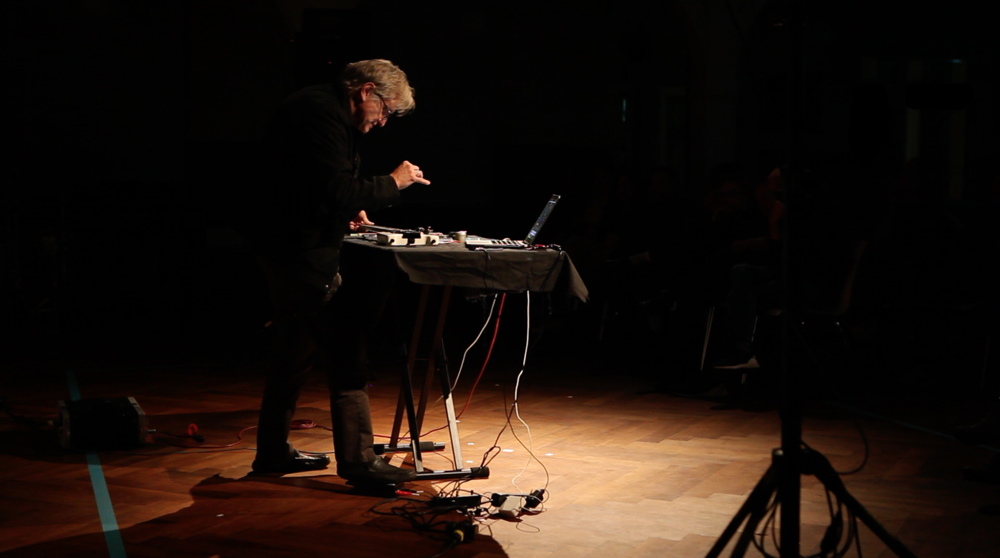
CD DEUS EX MACHINA - ENDANGERED GUITAR LIVE
Clang 042, released 2016. Total Time 54:18 Minutes. Recorded in concerts 2004 through 2011. Hans Tammen – Endangered Guitar Solo.
Buy original CD from my webstore here.
Liner Notes
Deus Ex Machina is a device that allows a character to unexpectedly intervene in a troublesome situation, by being lowered onto the stage from a crane. It is a suitable term for a music project in which the performer constantly struggles with the built-in unpredictable behavior of the instrument – in this case, the Endangered Guitar, a hybrid interactive software that is designed to surprise the performer. Of course, here I am the actor myself, who is lowered onto the stage, improvising a way out of any conundrum the software presents (in one case, even as the computer crashed). This is less complicated as it sounds since I am also the author of this stage play, and I wouldn’t let it go too far.Plus, I am continuously performing with the Endangered Guitar since the year 2000, so I know how it reacts to my playing. It is a hybrid between a guitar and a computer, with software programmed in Max/ MSP. Sounds are constantly recorded, and the information from the analysis of these sounds and my playing determines a wide range of timbral and rhythmic processes. From around 2004 on I programmed random elements into the machine, so that it surprises me on stage, and I do not settle into a routine. All pieces (except #6) are from this period, when the Endangered Guitar became an interactive instrument. Another reason for choosing these works is that these were new sonic universes – by then I had left behind the prepared guitar / noise formula that dominated my playing throughout the 90s, figured out which live sound processing approaches worked best, and developed a new rhythmic concept – eventually settling for Godfried Toussaint’s Euclidean Rhythms.
As with other releases, I organized the music around several themes, with short interludes in between that allow your ears to relax. The whole CD is framed by an introductory piece that gives you an overview of the works, and a last one that allows the listener to unwind. Except for the introduction, each piece settles on a central idea.
All pieces (except #6) are from live performances recorded between 2004 and 2011. The majority is from performances around New York City. Three recordings were made in Europe, at Re-New Festival Copenhagen and Karbonmusik Zurich (#1, #12 and #13). The Attack Study (#6) is recorded at home in 2003, it is more focused than similar ideas I presented live on stage later. Here the software records the picking in random intervals up to 15 seconds, and with every stroke plays back the recorded sample from the start. Playing a rapid tremolo on the lowest string (the pulse you hear is the actual playing), the only thing the performer is supposed to do is to change the pick position constantly, in order to supply the buffer with different attack sounds (hence the title). Pieces #3, #9 and #18 make heavy use of the Euclidean Rhythm concept. Each “drum” sound is recorded on the fly from the guitar playing, and replayed according to the Euclidean approach. Since the concept distributes sounds evenly in time, it allows for lots of phase techniques, one of my favorite musical tools.
More information about the Endangered Guitar project here.

Touching Extremes – Massimo Ricci
We have more or less grown used to the conception of an improvising guitarist divided between the control on a chain of effects and the few deviations from the basic route that those appliances may propose during a performance. Instead, Hans Tammen’s priceless creations are mainly born from computerized mechanisms that chew, guzzle and spit out tiny crumbles of the so-called (by myself) “overconfidence of the axeman”; the adventurous musician is left naked and running inside a thick forest of unpredictable responses. The procedures – clearly explained by the artist in the liners – appear quite comprehensible, at least to a degree; and yet, the results are utterly impossible to imagine if one’s mentally stuck in the classic roles carved in the stone of conjecture by the erstwhile “avantgarde”.So, think of a composite interaction of parameters transforming a sequence of instrumental gestures into a wide territory of semi-hostile discontinuity; percussive, droning, intricately colorful, or simply blowing your socks off. In this place, the role of the player is at once diminished (in terms of self-assured posing) and enhanced, for someone must take care of directing the startling reactions of the apparatuses towards a somewhat compatible musical outcome. Meaning “compatible” with alien harmonies, of course. Also interesting is the bizarre malleability of the rhythmic component: at times the music’s parallel paces seem dictated by a bunch of sequencers programmed by Conlon Nancarrow. Brain-displacing counter-pulses and accents of obstinate dissolution become useful tools in the fight against the sluggish dementia of most of today’s “art”.
Lastly, a question: is the (admittedly “endangered”) guitar still recognizable in this unwelcoming neighborhood? The answer is yes, sometimes. We hear the occasional jangle of a chord exhaling its last breath within a network of awkward profanities; the picking can be detected amidst the flabbergasting textural breakages; the tendency to resonate is barely contained by the wonderfully unmerciful incongruity – only apparent, mind you – of this revitalizing wholeness. At the end of the day, what’s the point of necessarily identifying a source when the contaminated sounds that it generates are curative? I, for one, love being put into this type of dilemma. I love it madly.
Oiginal post here.
Aural Aggravation July 2016 / Christopher Nosnibor
…Tammen writes of the computer crashing while performing, and of how wildly unpredictable the whole setup is, and this very much translates into the audio captured on the album.Scratched overdriven chords and discords splinter and snarl. Massive, distorted, overloading sludged-up Sunn O)))-like drones rumble on… and on… walls of sound collapse in on themselves. Pickups cut in and out intermittently, feed back and crackle. Occasionally, recognizable notes – albeit notes that sound like a version of Metal Machine Music are distinctly audible. There are no tunes to be found here, and often, it doesn’t even sound like a guitar. On ‘Transaxle’, the guitar effects the sound of violin strings being scraped, against a droning, wheezing sound like a deflating bellows, while on ‘Interlude at Rake’, it conjures a techno sound, replicating synth stabs and booming bass beats. Rapid, looping modulations, bleeps and squiggles replicate the effect of analogue synths, with sounds which would be at home on a track by Factory Floor or Whitehouse, and elsewhere, dark ambient passages hum, rumble, grind and billow and grating industrial barrages relentlessly assault the senses. At times, it hurts. But it’s also entertaining and often enjoyable: Deus Ex Machina is sonically challenging and one can’t help but contemplate just how the sounds of a guitar can be mutated in real-time to create the diverse and sometimes utterly insane sounds captured here. It’s by no means a novelty album, either: the concept of the Endangered Guitar may sound like something of a gimmick, but Tammen demonstrates that his leading preoccupation is with innovation for the purpose of creating new sound, and more importantly, creating something with those sounds.
Original post here.
NiteStylez.de / Baze.Djunkiii
Catching up on the last summer promos today we’re taking a closer look on Hans Tammen’s latest album “Deus Ex Machina” today which was released via Clang in the first half of June. Subtitled “Endangered Guitar Live” it’s pretty obvious what this album is dealing with – a nineteen track take on the artists work with the hybrid instrument, an amalgamation of live guitar and a computer running the Max / MSP software, documenting his approach to the well-complex and chaotic function of this extrordinary instrument in the years 2004 and 2011.The results of this can be fascinatingly clean and sci-fi sounding whilst being infused by a little bit of Post-PostRock in tunes like “Transaxle” or “Delusional Parasitosis” whilst bits like the “Planetary Gear Train (Euclidean I)” or “Attack Study” provide a little more Rock’n’Roll-feel in terms of energy, but – due to the nature of the instrument – are taking these towards entirely new levels of abstraction, naturally. The “Combustion Chamber” even provides absolute Vantablack darkness and is meant to creep the hell out of ppl suffering from depression and / or mental issues for a reason. In “Sun-And-Planet-Motion” Hans Tammen even explores the abstract art of single note picking on the Endangered Guitar whilst the subsequent “Epicyclic Train (Euclidean II)” as well as the “Jonval Turbine (Euclidean III)” unveal the heavier, slightly ultraviolent side of the instrument. Furthermore the “Interlude In Copenhagen” evokes memories of uncontrolled modular synthesis, “Deinoccus Radiodurans” brings in more bass heavy, yet glitchy low frequency despair for those who can handle the most lightless hours of the night before “The Interlude At Ramapo’s” finally brings in a little lighter, playful elements into the overall sound of “Deus Ex Machina” which defo is one album piece that’ll be more appreciated by those digging true sonic experimentalisms in all their different variations.
Original post here
ATTN:Magazine
I’m sure you’ve seen those home videos where someone suddenly realises their clothes have caught fire. Initially calm and oblivious, the victim promptly jolts into wide-eyed alarm and enters survival mode, thrashing around to shed the particular layer as quickly as possible, occasionally running in circles in a futile, botched-reflex attempt to escape the blaze. The situation is partly analogous to Deus Ex Machina, with the exception that Hans Tammen knows that his clothes will catch fire – over and over again. Nonetheless, the album still captures those moments of sabotaged consequential certainty; sudden mishaps rupture his progress, forcing him to promptly react to the unexpected intrusion and steer sharply into a different course of action. Listen closely, and one can hear the split-second onset of panic as his own instrument severs the feedback loop of expectation and fulfillment.I’m talking about the “Endangered Guitar”, which is Tammen’s self-made hybrid between electric guitar and Max/MSP software. Through analytical processing of the instrument’s rhythm and timbre, the computer twists his performance through randomised events, Euclidean rhythm and time-sensitive looping. “Chekov’s Gun” begins like a metal guitarist running through the presets on a multi-FX pedal, before the computer starts to hack up the performance into chattering blocks of distortion and digital pop. It’s possible to pinpoint the moment the computer seizes control: the stereo field becomes ravaged by helicopter tremolo, sending Tammen into a flurry of dissonant improvisation as he ducks and dodges the overdriven debris. “Attack Study” is the amplifier equivalent of a printer jam – a glitch of plectrum attack and low resonance, fed back into itself on rapid fire – while “Epicyclic Train (Euclidean II)” throttles the guitar until it starts wheezing and choking, creating a strangely propulsive dance of babbling fragments and whistling pitchshift.
It’s easy to forget that, as he states himself, Tammen is the “author of this stage play” – even the most erratic computer impulse is the output of his own processing decisions, which means that he’s never entirely flummoxed or overpowered by the sounds that Max/MSP puts forth. For all the bursts of the unexpected – the moments where guitar swerves to stay on a path that continually melts into disorderly chicanes – there is a very precise overarching choreography at work. Both components are gifted equal amounts of gravitas; neither dominates or utterly obscures the other, and even the strangest mutations of texture contain tiny shards of nylon string and plectrum attack. There’s always enough familiarity for Tammen to orientate himself and eventually correct course, even if the labyrinthine logic of Max/MSP can often shunt him to the brink of absolute obscurity.
Original post here
